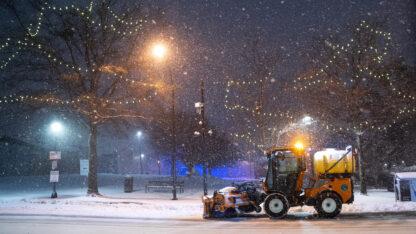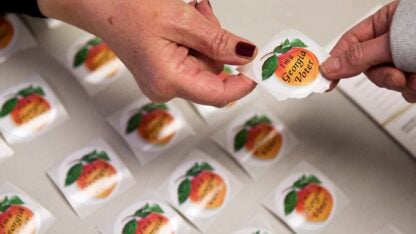Ga. College’s Reckoning Stirs Memories Of Nooses, Hazing, Pain

OLYMPUS DIGITAL CAMERA
Blastoids / Wikimedia Commons
Even now, the sound of a drum can carry Lori Morton back to Macon and a night of terror at Wesleyan College more than two decades ago.
With a bass drum pounding a steady beat, young women in hooded robes and face paint — and nooses around their necks — rounded up her and other first-year students.
Morton, who is African-American, was two weeks into her freshman year. She had no prior warning about what was coming that fall night in 1991 as she and other students, some black, some white, huddled in the darkness. Suddenly, a figure in a purple robe rode up on horseback.
“I remember being absolutely terrified,” said Morton, a family therapist and minister from Fort Lauderdale, Florida. “I didn’t know what was going on.”
Morton’s night of terror was part of an initiation tradition that stretched back nearly 100 years to a time when the college was all white and celebrated the Ku Klux Klan through class names and hazing rituals passed down from one class to the next.
Now, she and other alumnae have broken a long-held silence about their experiences at Wesleyan in the weeks since a June 25 Atlanta Journal-Constitution article detailed the school’s historical Klan ties and the racist traditions that persisted for much of the 20th century.
On Facebook and by telephone, alumnae have shared painful memories from their years at America’s oldest women’s college and disclosed the lasting effects those experiences had on them.
Painful Memories, A School’s Legacy
The outpouring has forced college administrators to acknowledge the school’s legacy more forcefully, and revealed that racist hazing rituals using nooses persisted far longer than the school had previously disclosed.
The stories of nooses and hooded riders from Morton and others in the early 1990s suggest that scores of black women were subjected to similar rituals during the roughly 25 years after black students were first admitted to the college in the late 1960s.
Wesleyan President Vivia Fowler said she’s learned of “hurtful” initiation activities that occurred as late as 2013 and is considering policies for swift punishment if anything happens again.
“These conversations have revealed instances where initiation rites — far too long tolerated by the college — caused pain that lingers even today,” Fowler told the AJC.
Some alumnae have also expressed embarrassment that, as young college students, they didn’t recognize the racist traditions that school officials tacitly sanctioned for decades. Others have apologized and described remorse and shame.
“What happened during the (initiation rituals) was not OK,” said Holly O’Reagan, a 1994 graduate who lives in Atlanta. “I had the privilege of naiveté to not recognize the symbolism as I’m a white woman. Some of my sisters did not have that privilege. They knew exactly what all that stuff meant.”
A Rush To Atone, Then A Backlash
In late June, Fowler apologized for the college’s legacy of racism. The outpouring that followed has included dozens of messages on social media and mixed expressions of anger and support among an alumnae that has never been more engaged about the topic of race on campus.
At a school steeped in traditions dating to 1836, the swirl of emotions has thrust administrators and alumnae into uncomfortable terrain: how to heal a campus community that is proud of its history, but wounded by it.
The first links between the school and Klan symbolism date to 1908 when a local news article reported students wearing masks and hoods inducted two “unfortunates” into that year’s class, which called itself the Ku Klux Klan. The 1913 yearbook was called the “Ku Klux” and later classes adopted names such as the Tri-Ks or, later, the Tri-K Pirates.
Nooses and effigies joined hoods and robes as part of the hazing rites, though it is unclear when. Numerous photos from the 1950s show white students with nooses around their necks and their faces painted black and white. Other photos show figures hung in effigy.
It’s unclear exactly what the symbols and rites meant to the students. But the practices relied on symbols that were racist and intended to be scary and intimidating. The lore that evolved over time was that a Wesleyan student early in the 20th century had hung herself when she was rejected by a sorority.
The hazing traditions were developed long before the school integrated in the late 1960s. But school administrators allowed them to persist for decades as the school evolved. Today, roughly a third of its 700 students come from other countries. Another third are minorities and a third are white.
Opinions vary, but all agree the college waited too long to acknowledge its troubling history and to make amends, Fowler said.
The painful impact of the school’s racist traditions on some former students seemed to catch administrators off guard. Some black alumnae criticized them sharply in late June when leaders rushed to revise the official Wesleyan history on the school’s website to include the Klan legacy and its historical ties to slavery. (The school’s first president was a slaveholder.)
Critics found the revised version offensive because it downplayed how long the initiation rituals continued, and accused the school of glossing over recent racism on campus.
School leaders quickly pulled the account from the website and have said they will take a more methodical, careful approach to telling this story. On Aug. 17, a campus-wide service for racial reconciliation will discuss how to incorporate the story of race into the school’s history.
The school has also put out a call for all alumnae who want to share their stories and participate in an oral history project that current students will conduct this fall.
“We are working to learn about and understand our history and to make amends,” Fowler said. “During the process of uncovering and discussing our institution’s past, we have learned many things we still need to work on today.”
Rituals Persisted After Black Students Admitted
For much of its 181-year existence, Wesleyan was an institution that served women from elite, white families who came to Macon from across the South.
A group of African-American students, known as the “First Five,” are celebrated for integrating the school and breaking down racial barriers when they graduated with the class of 1972. In the fall of 1968, the school newspaper greeted them and other freshmen with a cartoon of a terrified figure staring at a noose with a caption that read: “Welcome Freshmen!”
But at least one other black student is not acknowledged in the school’s history. Pat Brown enrolled in the fall of 1966, but only stayed for a semester, according to Karen Huber, a Wesleyan history professor who is researching the history of race on campus.
Until now Brown has not been included as part of the school’s history of integration. The school has no record about her experience in freshman initiation or if it played any role in her reason for leaving.
“The records we found do not indicate why she left,” Huber said. The AJC tried unsuccessfully to locate Brown.
As more and more minority students enrolled in the 1970s and 1980s, the initiation rituals remained largely unchanged. Students continued to use hoods and nooses that were passed down from class to class.
Some nooses were decades old and had ribbons around them with the class year and name of those who’d used it and handed it down.
‘Absolute Terror’
That began to change in the fall of 1991.
Morton’s class was one of the most diverse to enter the college. Angel Robinson, an African-American woman from New Orleans, was also part of that group.
Encouraged by a recruiter to apply, Robinson quickly fell in love with the school during a visit her senior year of high school.
Two weeks into her freshman year, her idyllic image collided with the school’s traditions.
The slow, haunting beat of a drum in the middle of the night and a chanting procession of people outside her dorm filled her with “absolute terror.” Ordered to follow, she marched in a state of shock.
“I just moved with the herd and followed along,” she said.
The initiation ritual became a “defining moment.”
For years, she said she had the same recurring nightmare about that night. She would hear the loud, violent pounding on her dorm room door and the sound of the slow drumbeat. The door would open and she would see a menacing figure standing in the darkness with a robe and a noose.
“That moment was the living embodiment of everything that I had been taught as a young black child about what the black experience had been in America,” she said. “I never thought I would come face to face with somebody wearing a robe and a noose telling me, ‘Silence and come on.’”
At the end of the hazing weekend, she and other first-year students were handed a noose and a potted plant as tokens they’d completed the initiation. The experience angered and confused Robinson. She said some friends made the decision to leave the school after the hazing.
Robinson became part of the group that started pressuring the administration to end the racist traditions. On a trip home to New Orleans that fall she showed the noose to her family — and then burned it in her kitchen sink. She was determined it was not going to get passed down to another student.
There was one silver lining, she said. “People found their voice to go to the president and the administration to talk and talk and talk until somebody would listen,” she said.
Students Clash Over Nooses
Judi Durand was class president in her freshman (1991) and sophomore (1992) years. Of Caribbean heritage, she initially opposed the school’s rituals because she found them satanic and offensive to her Christian faith, but soon recognized the racist symbolism they conveyed.
She said the administration at the time was not receptive to their calls to end the initiation rituals.
Tensions grew on campus and the group pushing for change started to feel intimidated by the administration, Durand said. The black cafeteria staff warned the students to be careful.
“The kitchen staff knew a lot,” Durand said. “They would whisper things. ‘Watch yourself, sweetie. You’re so sweet. I don’t want them to hurt you. Watch yourself going up against these white folks.’”
The students presented a particular challenge to a tradition-heavy institution that was founded as the first chartered college for women in the United States.
School leaders encouraged Durand and others to work out their grievances with the faction of white students who wanted to keep the nooses. Durand said she lost friends over the fight. Some white students accused them of trying to destroy the school’s traditions, she said.
When the group refused to back down, the school eventually agreed to get rid of the nooses after the 1992 initiation rituals, she said. The nooses were collected and replaced with a chain of ribbons that were put around the students’ necks.
“How we got the nooses off that campus was an act of God,” said Durand, a public relations professional. “We were not in the majority, but a noose is overt. A ribbon you can explain away.”
‘I’m Ashamed’
Marcia Fears, who is African-American and lives in Smyrna, participated in the hazing as a freshman and sophomore in the early 1990s. She said she was a young college kid and didn’t think a lot about it at the time.
Now, she sees her experiences differently. She recently pulled out old photos of her wearing a robe and a noose and showed them to her fiance. She’s since learned that some students left Wesleyan because of the hazing. It hurts to think she’s part of that history and what it represents.
“I’m affected by this just as much as other people,” she said. “Now, looking back, it’s something I’m ashamed of. It upsets me.”
Despite her own hazing experience, Robinson said she loved her time at Wesleyan and still cares about the school. The recent engagement of so many alumnae has encouraged her. She hopes the school will use the examination of its past as “a teachable moment.”
Morton, whose family traces its lineage to former slaves in Georgia, said the hazing and the fight to get the nooses off campus was a bruising experience. She still doesn’t like to hear the beat of a drum. Seeing people with painted faces makes her anxious. At one point during that initiation weekend, she and the other freshmen were led into the woods and met by hooded figures wearing nooses. For years afterward, she had dreams about the experience.
“Coming face to face with a noose for the very first time in my life was just like, ‘I can’t even handle this,’” Morton said. “We’re really big in our family (about) tradition and we talk openly about slavery and Jim Crow and what our family went through, so it wasn’t OK for me.”
It also defined her friendships at Wesleyan. There were the people holding onto the traditions and those opposed to them. Morton hasn’t returned to campus since she graduated in 1995.
“I think the residue of that experience is always with me,” she said. “I don’t think I’ve ever been free from that experience. It does make me sad. I don’t think they understood how far-reaching that process was for me or how hurtful.”
9(MDAxODM0MDY4MDEyMTY4NDA3MzI3YjkzMw004))








